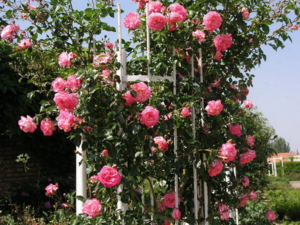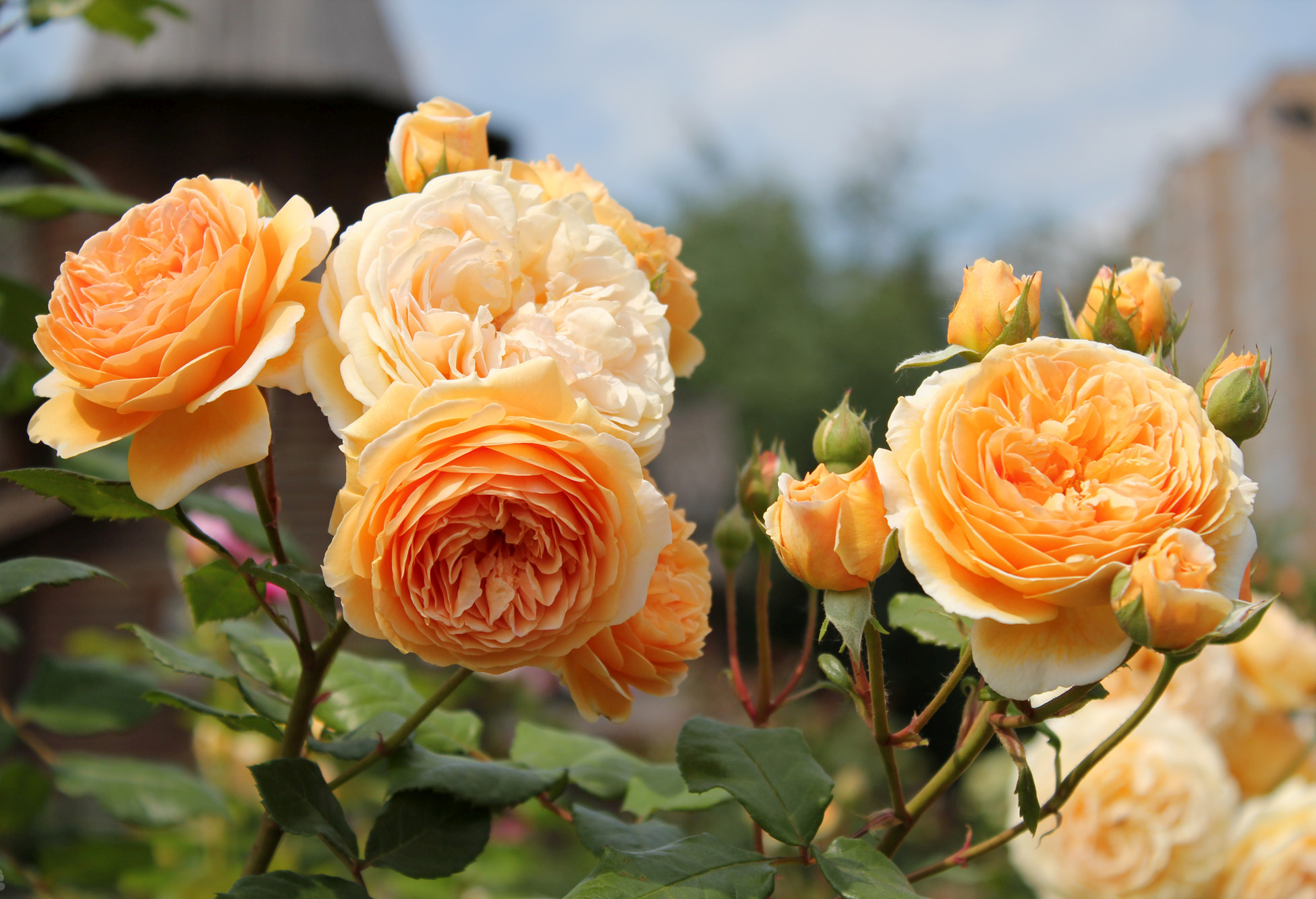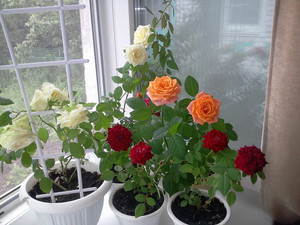 Many indoor plant lovers prefer to have a rose among their pets. This is not prevented by the whimsicality of the plant, susceptibility to pests, difficulties in care. In addition to the beautiful bloom of the "queen of flowers", rose bushes create a unique style for a botanical corner.
Many indoor plant lovers prefer to have a rose among their pets. This is not prevented by the whimsicality of the plant, susceptibility to pests, difficulties in care. In addition to the beautiful bloom of the "queen of flowers", rose bushes create a unique style for a botanical corner.
Even a single one can elegantly decorate the window indoor rose... Propagation of this plant by cuttings retains all the characteristics of the original species and enjoys an advantage over other methods.
Content
What roses are bred and grown in the room
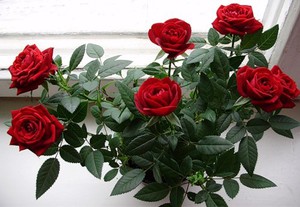 Indoor indoor roses come in a variety of colors. Miniature varieties usually have very slender bushes, exactly repeating the most beautiful tea and hybrid tea species.
Indoor indoor roses come in a variety of colors. Miniature varieties usually have very slender bushes, exactly repeating the most beautiful tea and hybrid tea species.
There are a lot of varieties and types of roses. For indoor growing, take compact plants, because the root system of a rose requires quite a lot of soil, does not like constraint.
Potted crops can be the following types of home or indoor roses.
- Rose Cordana (Rosa Kordana) - small size, lush, odorless.
- Miniature roses.
- Climbing roses - have elongated stems.
- Shrubs.
These are just some of the varieties that can be cut and grown at home. Do not force hybrid tea garden roses to grow in the room. They are almost do not lend themselves to grafting in room conditions. How to propagate roses?
Reproduction methods
The following methods of propagation of these flowers are known:
- seeds, which is very time consuming and almost never practiced;
- cuttings of roses is the most common and popular way;
- layering, if the stems are long, climbing.
Also, a rose is grafted onto a rosehip, obtaining a copy of the desired variety. But this is no longer reproduction. And also grafting is used exclusively in horticulture.
How to propagate roses by cuttings? Many species propagate by cuttings, but this is not always an easy task. Rose Cordana, for example, difficult to reproduce... And miniature varieties intended for rooms, interiors, cuttings are easier.
Method of growing roots in water
This method is most suitable for miniature and dwarf roses. Roses are propagated by green cuttings most often. These are annual shoots that have given buds. For the formation of roots in water, it is recommended to follow these rules.
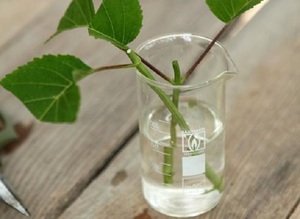 The best period is spring and summer, characterized by long periods of natural daylight. Then the plants grow actively and give buds.
The best period is spring and summer, characterized by long periods of natural daylight. Then the plants grow actively and give buds.- It is believed that the most suitable shoot for grafting should have a bud. But if you don't want to deprive yourself of flowering, you can take a faded stem.
- The knife or pruning shears should be sharp so as not to leave jagged edges on the stem as a source of infection.
- The stalk must have more than two buds from which new shoots will grow.
- From the bottom, the cutting is cut along an oblique line, and from above - along a straight line. Length - no more than 15 cm.
- Florists consider it correct to use boiled water for growing roots, considering raw water unsuitable. In any case, the water must be settled for several hours, heated to room temperature.
- For the growth of roots in water, dark containers, opaque or made of dark glass, are more suitable.
- Each container with the material should be signed if the varieties are different.
- The water is not changed, but topped up as it evaporates.
- Jars of roses should be in a bright place, for example, a windowsill.
Features of the method of growing roots
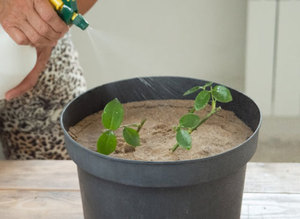 According to one opinion, when roots appear, the rose is placed in the ground. This increases the chances of survival, and the plant itself does not weaken.
According to one opinion, when roots appear, the rose is placed in the ground. This increases the chances of survival, and the plant itself does not weaken.
Other growers believe: the appearance of roots in miniature roses takes up to three weeks and grows them up to a centimeter. They must branch out. They are planted in a container of 200 ml with holes for draining water.
Some take into account the phases of the moon and believe that landing should be done on a waxing moon. But in order to take this factor into account, you need the moon to shine through the window, giving the plant additional lighting.
That is, the windows should be south, on the north side it does not matter. Besides, waiting for the "correct" moon, you can miss the time for a successful planting, weaken the plant.
Very often, the first bloom of a rooted rose does not have to wait long, the bud appears soon. But it depends on the variety and other conditions.
After the first flowering, the plant is recommended transplant into a spacious pot... The roots should be at the same level in relation to the surface. If a long and weak shoot appears, it is cut off, leaving 36–40 mm above the soil.
Rooting cuttings
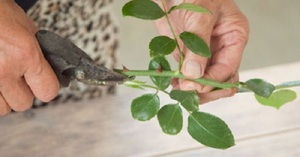 Breeding material - cuttings are obtained in the process of pruning indoor roses. If the rose grew on the street, but is small in size, suitable for indoor growing, branches can be taken from it.
Breeding material - cuttings are obtained in the process of pruning indoor roses. If the rose grew on the street, but is small in size, suitable for indoor growing, branches can be taken from it.
But not every garden rose variety will take root in a pot. The climbing rose is considered suitable for rooting. But the tea garden rose almost does not give good results, except for a small percentage.
The most suitable shoots for rooting are received in spring and summer, with ripe buds or flowering. Long shoots are fine too. A prerequisite is the presence of kidneys. The length of the handle is up to 12 cm.
A knife or scissors for slicing is desirable disinfect alcohol or potassium permanganate. The cut is made under the kidney below and above the kidney at a distance of up to 1 cm from above. The existing leaves are cut in half.
Rooting method in the ground
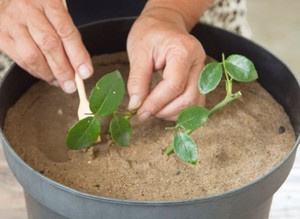 Cuttings are planted in the ground immediately after cutting. There are drugs that promote rooting. In the preparation "Kornevin" you need to dip the lower cut of the cutting. And from the means of "Epin" they make a solution in which the slices are kept for up to half a day.
Cuttings are planted in the ground immediately after cutting. There are drugs that promote rooting. In the preparation "Kornevin" you need to dip the lower cut of the cutting. And from the means of "Epin" they make a solution in which the slices are kept for up to half a day.
Stalk immersed in the ground 1/3 and compact the soil. Naturally, before harvesting the cuttings, containers with soil must be prepared. Each container is covered with a jar or a common greenhouse is made under the film.
The moisture in the greenhouse evaporates slowly. Therefore, you do not need to water every day. Favorable soil temperature - up to 25 degrees Celsius.
Roses are required good lighting required... If it is impossible to put them on the windowsill, we make the backlight (daylight hours - 15 hours). Rooting period - up to 5 weeks. When the leaves begin to grow, then air can be supplied to the greenhouse, and then completely remove the film (jar).
If rooting was done in a common container, over time roses seated one by one... The distance between the roses should be about 5 cm. Being in the light, the roses should not be exposed to the scorching sun.
With the growth of the root system, a lump of earth is transferred to a large container. In a 500 ml container, the rose can live until next spring without transplanting. Normal care: watering, temperature conditions.
In autumn, they can stand on the veranda, in cool conditions. In winter, you also need to keep them away from the heat of the battery.As the winter day begins to increase, the plants will respond with growth. In the first year, you should not expect abundant flowering, since it occurs later with thorough rooting.
Rooting by air layers
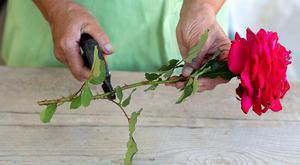 If the culture of compact (indoor) size has long stems associated with the variety - climbing, then it can be propagated by layering. This is a more reliable method that is not life-threatening for the rooted branch.
If the culture of compact (indoor) size has long stems associated with the variety - climbing, then it can be propagated by layering. This is a more reliable method that is not life-threatening for the rooted branch.
Air layers can be rooted in any plant. And this is exactly what they do for reliability, if the cuttings are not enough. When propagating by layering, it is advisable to take a flowering branch.
Leaves are removed from the bottom and make longitudinal cuts a sharp cutting object (razor or knife) on the bark. Then put a bag of sand in place of the cut. This soil needs to be moistened regularly for rooting.
After three weeks or less, root buds will begin to develop on the incised stem. With a darkening of the stem in the place of the cut and the absence of roots, the conclusion is drawn: rooting by layering did not work. It is necessary to cut this shoot above the spoiled place and plant it in the form of a cutting.
You can learn about successful rooting by the growth of new shoots. Need to moisten the soil regularlyavoiding excess moisture. Drying out is also unacceptable. The size of the pot is also important.
Soil and fertilizers... Ready-made soil for sale in packaging for roses, which has all the necessary components. You can also make a soil from a mixture of sand and peat.
Sod sand is a good soil composition for the further development of the plant. The substrate is prepared by taking light soil, adding to it twice as much turf, the same amount of peat and a little sand.
Humus is a good fertilizer for roses. When new leaves appear on a rooted rose, you can make mineral fertilizers and organic.
Container size and greenhouse conditions
The opinions of florists differ. Some insist on the correspondence of the pot to the size of the plant and believe that the cuttings need a small capacity, no more than 200 ml.
Others say: the rose loves a large amount of soil and you can immediately take a larger pot. One way or another, the container should have a good drainage, drain holes.
After the roots have taken up all the space in a small pot, the rose must be transplanted directly with a clod of earth into a larger container. If the pot is too large, there is a danger of uneven moisture, moisture stagnation, pests that spoil the roots.
When a single rose is rooted in a balcony box, other plants with similar climatic preferences can be planted there. It is quite possible to plant several cuttings of a rose in one box.
It is required to take into account that wind and draft are also harmful to the culture during rooting. For protection from wind, as well as for long-term preservation of moisture and creating the necessary climate use greenhouses... This is a plastic wrap covering a container or jar for each bush.
Dangers and pests
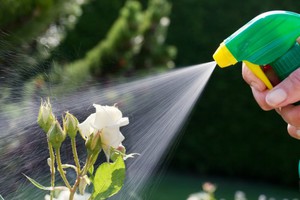 Spider mites are perhaps the most common cause of plant disease. Signs of infection - yellowing leaves, stuntedness... Sometimes a home flower cannot be saved. Regular inspection of the foliage of the plant from the back side, as well as the tops, is required.
Spider mites are perhaps the most common cause of plant disease. Signs of infection - yellowing leaves, stuntedness... Sometimes a home flower cannot be saved. Regular inspection of the foliage of the plant from the back side, as well as the tops, is required.
Although the healthy appearance of a houseplant speaks for itself, drugs are used to combat spider mites when they are detected, for example, Fitoverm, potash soap for spraying.
Mini roses are resistant to disease, but sometimes they are affected powdery mildew - gray bloom on foliage. The result of the disease is yellow leaves. Aphids are also a pest that can infect a delicate plant.
And this happens in a weakened state, caused by waterlogging of the soil, excess fertilizers. In order to avoid ticks, it is recommended from time to time spray bushes.
The mold that has appeared must be washed off the plant, as well as the entire windowsill must be cleaned, and allowed to dry. Good air circulation and ventilation are needed against mold.
A home rose garden doesn't just decorate a room and its window. With the help of this beautiful and harmoniously created plant, you can achieve a chic floral design for the illuminated area of the interior.
If you have the skills, new plantings are made, even rooting roses from bouquets. Having for a start one indoor rose, over time you can acquire a whole plantation. Moreover, there are compact varieties of beautiful indoor roses.
Rose care provides seasonal pruning of shootson which to try rooting methods. If the cutting methods are different, then you should always divide the batch of cuttings into two and look for suitable rooting conditions using both methods. After all, the conditions for adaptation differ depending on the variety and other factors.
